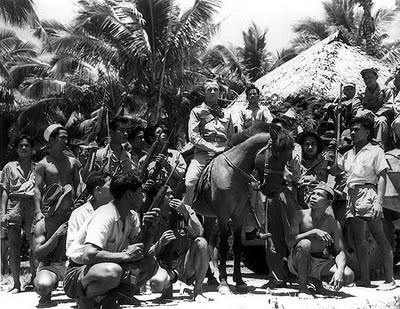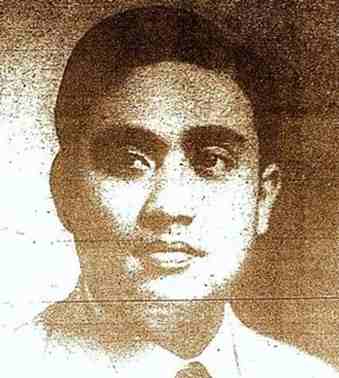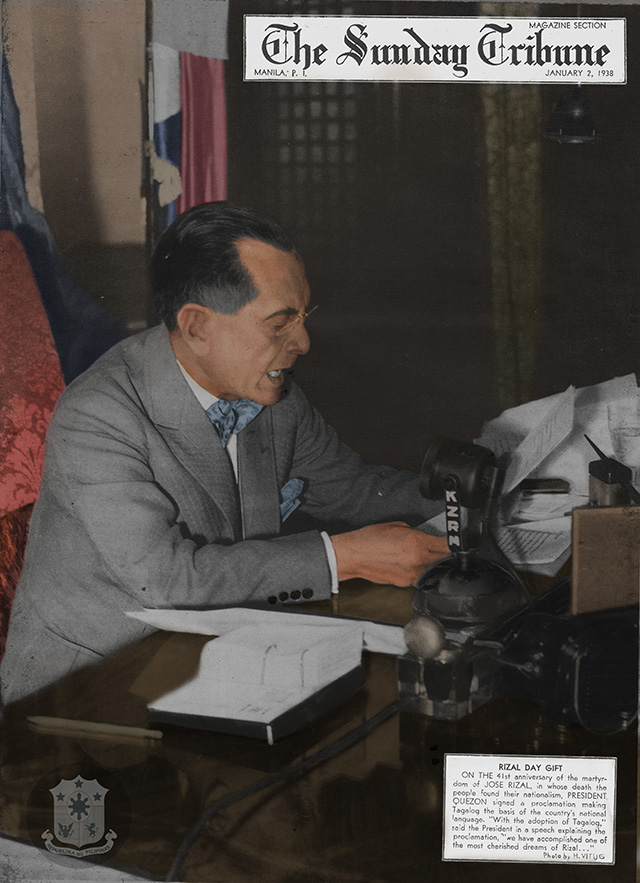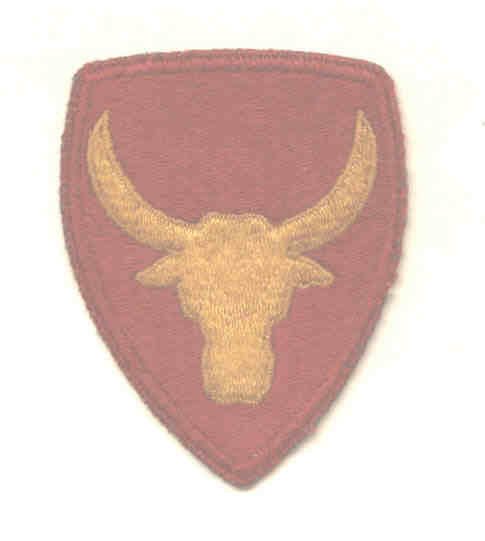Carabao English

During the war, Filipino Guerrillas speaking different dialects would talk in English or Spanish in order to understand each other since the Tagalog dialect was not yet thoroughly implemented as the National Language. Capt. Locolvero on horseback with his barefoot army of Chavacano, Tausug, Visayan and Tagalog speaking guerrillas in Zamboanga. 1945
The Philippines boasts of having eleven languages and 87 dialects spoken in the country. Of these 11 languages, 8 are derived from the Malay-Polynesian language family. No two of these are mutually comprehensible. No wonder then, that for the early American colonizers, it was easier to teach the Filipinos the English language than to learn every native Filipino tongue, thus adding a new language that the Filipinos of today now enjoy. During the early days of the American Occupation, It is said that at least 70 percent of the Filipinos could speak and understand Spanish well.
When the Philippines became a colony of the United States, the Americans now introduced American English to the Filipinos and within 40 years, they accomplished more in terms of educating the Filipinos than the Spaniards with their over 3 centuries of rule ever did. Yet where the upper reaches of the colonial state was concerned, Filipino leaders continued to speak Spanish rather than English. In fact, Spanish dominated the language of the Philippine courts of law until the eve of the Pacific War, so that colonial legislation as with the proceedings of the Philippine colonial legislature was primarily in Spanish accompanied by English translations. Hence for the Filipino prewar elite, English continued to be a new and foreign language. As such it could not as yet function as the primary idiom for expressing class identity and national consciousness in the way that Spanish and the local languages has been able to do.
And as to communication between Filipinos speaking different dialects, especially those coming from other regions, the communication gap is wide. Proud of the local language that he was born to, a Filipino would tend to promote his own native tongue over that of another. When it comes to learning Malayo-Polynesian based Language however, the average Filipino is a natural linguist. To be truly Independent, the need to have a Filipino based National Language has come of age.

Wenceslao Q.Vinz0ns ( photo from camarinesnorte.gov.ph)
in 1935, Wenceslao Q. Vinzons , one of the young and brilliant delegates to the constitutional convention under Pres. Manuel L. Quezon, Although not a Tagalog himself, supported Pres. Quezon’s proposal to develop a national language based on Tagalog. The non-Tagalog delegates protested the proposal but Vinzons drafted the present text of the section of the National Language, making it more acceptable to the other delegates. This led to the adoption of the proposal. . Vinzons however, never saw the fruit of his work. On July 15, 1942, he was killed by the Japanese for refusing to swear allegiance to them.
It was on December 13, 1937, that President Manuel L. Quezon issued Executive order No. 134, s. 1937, approving the adoption of Tagalog as the basis of the national language of the Philippines, and declared and proclaimed the national language so based on the Tagalog dialect, as the national language of the Philippines. The Law however was not thoroughly implemented, and the concept though sound was still in its infancy and has not caught on.

President Manuel L. Quezon, live on air during the proclamation of the “National Language of the Philippines”. December 30, 1937. Photo by PCDSPO
By 1942, most Filipinos in Cities and big towns could understand English, Many young Filipinos from affluent families were educated in America and the big universities and colleges all over the Philippines were teaching English to the second generation of English speaking Filipinos. In the provinces however, the local language was still the dominant tongue of the Filipinos and English was a work in progress. By this time, however, the dark clouds of World War 2 has covered the entire archipelago and the Japanese Occupation had begun.
Sgt. Walter Wallace of the 8th Australian Division was an escaped POW from the Japanese prison camp in Sandakan, on reaching Mindanao, he became a member of the 125 Inf. Regt. United States Forces in the Philippines (U.S.F.I.P.) and as such became the Chief Instructor to the Regiment – teaching Filipino Guerrillas in Mindanao, basic Morse code in Signal Class. Though naturally a linguist when it comes to Malayo-Polynesian Languages and with Spanish pronunciation of words deeply ingrained into most of the native dialects, The Filipinos would often times struggle with the new words especially those that had no direct translation to the speaker’s own tongue. It was turning out to be a difficult job. In his memoire, Sgt. Wallace recalled an opportunity to immerse himself into the intricacies of the Filipino tongue with a Corporal of the Philippine Scouts as his teacher. (From his Memoire: Escape from Hell)
“Sir, would you like to learn to speak our language?”
“Sure, I would,” I said, for I thought it might be useful to address my men direct, in their own tongue, instead of having to rely upon an interpreter, and we started off on a lesson there and then. I asked him to tell me what to say if I wanted to call a man to come to me.
“Currie-co” he told me.
I memorized this, and then said:
“And if I want to call all the men?”
“Currie-co-mo,” he replied.
The next morning I tried out my new-found knowledge. “Currie-co-mo I” I called.
Not a man moved, so I called again. Still no one made the slightest effort to obey the order. I called the corporal over and asked him why.
“Oh, sir,” he said. “All these men come from different islands from the one I come from, and each island has its own dialect so that they do not understand what you said.”
There are about a thousand islands in the Philippine group, so it seemed that the two words I had might be said in a thousand different ways.
“But how on earth do you get on if you visit another island and you want to talk to someone?” I inquired.
“Oh, sir, that is easy,” he told me.” I just find someone who can speak English.”
After that there didn’t seem much point in going on with the language lessons.
The Filipino soldiers under the Americans were perhaps the first group of Filipinos coming from different regions that were thoroughly exposed to the new foreign language. The Philippine Scouts was a military organization of the United States Army from 1901 until the end of World War II. Made up of Filipinos assigned to the United States Army Philippine Department, these troops were generally enlisted and under the command of American officers, however, a handful of Filipinos received commissions from the United States Military Academy. Philippine Scout units were given a suffix of (PS), to distinguish them from other U.S. Army units.
Recruited by the Americans to first act as guides for their troops and liaisons to the Civilian population, the Filipino recruits also proved to possess innate knowledge on martial skills and an inexhaustible supply of Valor. The Scouts soon enough became a valuable component of the American Military organization. As the Americans recruited scouts from all over the archipelago, communication became a major problem. A case in point: The 11th Philippine Infantry under Col. Russell Volckmann encountered severe language difficulties. In one regiment alone, no fewer than eleven dialects were spoken. A typical machine gun crew could have scouts from different regions with diverse dialects. A five man team could have five men with different dialects obeying English commands from an American officer.
Ordered and drilled in English, the scouts naturally took to American English as the medium for which to understand each other. While some Filipino soldiers excelled in the English language like ducks on water, many of the soldiers, especially the Enlisted Personnel with little or no formal education on English grammar struggled with the foreign language. But with the Filipinos knack for adapting to new environments, they too, soon learned to speak English enough to be understood, and of course, to be misunderstood.
Here is some humor on “Carabao English” from the Guerrilla front of Cebu. (Excerpts taken from the book TABUNAN)
Indeed there were light moments in the hills to punctuate the grimly serious business of life and death. We were always looking about for something to ease the tension and bring laughter.
Ariarte was a councilor of the town of Toledo. He spoke a little Spanish, which was not as much as his English. We remember him for the little phrases in English which he said in all seriousness but gave us all a hearty laugh. Ariarte’s job was as procurement agent in the Central Cebu Sector. The first time he brought supplies to Tabunan in early 1942 we hoped that his English would not get him in trouble with the co-commanders. Apparently he got in their good graces for he came into our Pandong-bato HQ proudly sporting lieutenant’s bars on his shoulders. He pointed to them and said,
”Sir I was lieutenated.”
Once in Toledo, he was assigned to an outpost. We received this Little-Red-Hen letter from him:
Dear Sir:
The Japs are coming. Please send help. Help, help, help, please, help!
Lieutenant Ariarte
Officer of Outpost No. 1
Succeeding messages arrived:
Sir, the Japs are here because I hear a hammering and a hammering.
Sir, I saw the Japs ride the launch. I fired the launch and it run rapidly and disappeared.
The last message was:
Sir, I withdrew because the launch will encircle us!
When Babag had that big battle in the first week of December 1942, reinforcements from the Central Cebu Sector were sent under Lt. Pedro Zuniga who took Ariarte along as procurement officer. They arrived in the early evening with no moon or stars in the sky. Zuniga raised his voice and called: “Lieutenant Ariarte, where are you?” Ariarte who was following very closely behind Zuniga answered apologetically, “Sir, I’m at your backward, sir.” “All right, Ariarte, take care of housing the men.
“Yes, sir,” he answered, then gave the order, “All right men, deploy in the house.”
When Ariarte was detailed temporarily at the Central Cebu Sector HQ, a message came informing of the expected visit of Majors Cushing and Fenton. Upon hearing this, Lieutenant Ariarte turned to the sector adviser, Captain Bradley.
“Sir, Major Cushing, Major Fenton coming. How many chickens shall I die?”
Without batting an eyelash, Bradley extended the fingers of both hands and answered, “Die ten chickens.”
Later, when serving the co-commanders with some fruit, Ariarte said, “Sirs, some avocados to appetite the majors.” (Col. Manuel F. Segura)
Ironically, the Tagalog dialect, chosen to become the National Language or the Filipino Language as it is called now was not instituted during the American period but during the time of Pres. Laurel under the Japanese Occupation.
The Kapisanan ng Paglilingkod sa Bagong Pilipinas (English: Association for Service to the New Philippines), or KALIBAPI, was a Filipino political party that served as the sole party of state during the Japanese occupation. It was intended to be a Filipino version of Japan’s governing Taisei Yokusankai party.
Taking a highly nationalistic standpoint, KALIBAPI was active in initiatives to promote the Tagalog language as a central feature of Filipino identity. To this end a pared-down, 1000 word version of the language was promoted to be learned rapidly by those not yet versed in the language. But, for the Soldiers and Guerrillas fighting the Japanese, business was still conducted in English as usual.
Could the Term “Carabao English” first coined by the Americans to mean the kind of “broken English” used by the Scouts? I can only assume. Incidentally, the shoulder sleeve insignia of the Philippine Division consisted of a gold carabao (the beast of burden of the Philippines) on a red shield. The insignia was adopted on July 8, 1922 until World War II.

Philippine Scouts Shoulder Patch (from The Philippine Scouts Heritage Society)
Books used as reference: White Love and Other Events in Filipino History by Vicente L. Rafael
Kerwin Salvador P. Caragos




